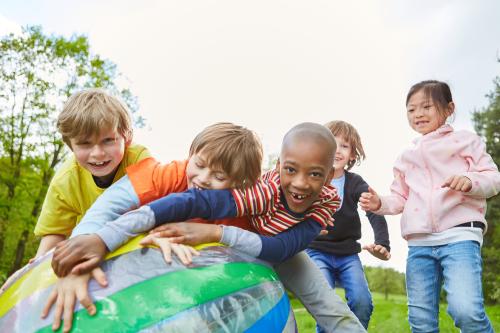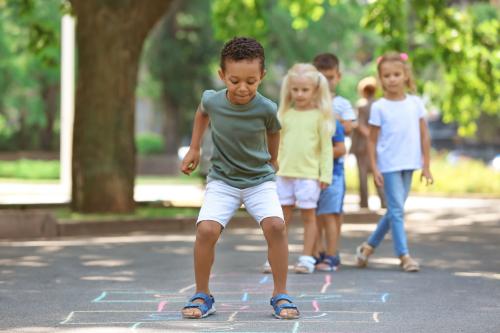Play is an important part of children’s learning and development. While it generally evokes a picture of a small child running, jumping, and shouting, the benefits that play offers in promoting early development and better health outcomes extend far beyond childhood. In fact, playful learning—an area of research that examines how children learn best through playful exchanges—shares many of the same core foundations as the study of intergenerational learning—a body of research involving older and younger generations coming together in the service of mutually-beneficial learning experiences.
As the COVID-19 pandemic introduced new layers to our understanding of the importance of social connection for a range of outcomes, researchers have an opportunity to look to the future of the playful learning and intergenerational learning movements together—what they share and how they can be leveraged jointly to support social interactions that foster well-being throughout life.
Playful Learning Landscapes support enriching interactions and promote learning
As a natural medium for fostering rich interactions, play creates opportunities for children to develop language skills, engage in collaboration, test theories about how the world works, and even develop better self-regulation. Child development experts, recreation and play professionals, and educators have long examined the connection between play and learning—and, more recently, how the kinds of enriching interactions that take place during play can be fostered through the built environment.
Enter Playful Learning Landscapes: a growing movement of community-based research partnerships across a number of cities in the U.S. and abroad, including in Brazil, Israel, and South Africa, that morph public spaces in places that foster interaction, learning, and joy (see illustrative photo below). By reimagining everyday environments in ways that encourage play while embedding a targeted learning goal, the movement fosters a learning model known as playful learning, in which children build content knowledge while simultaneously playing freely. Playful learning research has not only generated improvements to children’s language and literacy, numeracy, spatial reasoning, and executive functioning—all skills that set the foundation for later development and school readiness—but also strong civic engagement, increased ownership of communal spaces, enriched interactions between children and their caregivers, and a deeper understanding among caregivers of the role of play in their children’s learning.
This PLL installation, which is located in Philadelphia, is called Urban Thinkscape.
Photographer credit: Sahar Coston-Hardy Photography.
But the benefits are not for children alone—playful interactions can also be a boon for older adults, supporting better health and social engagement, staving off cognitive decline, and creating multigenerational learning opportunities with intergenerational impacts.
Intergenerational research showcases benefits to, and contributions of, older adults
A century ago, multiple generations lived, worked, and played together. Today, much of our society treats young children and older adults as fundamentally different from one another—and, more likely than not, we live apart, sometimes a great distance, from even the closest generations of our own families. We now each belong to a separate “named generation” that reinforces generational differences, which may contribute to the persistent and widespread problem of ageism, that has well-documented negative effects on physical and mental health, economic well-being, and access to critical support services. Though the developmental literature acknowledges that many of our needs evolve as we age, the benefits we experience from rich social connections, learning opportunities that support cognitive function, and activity that promotes physical health remain constant throughout life.
The intergenerational movement, which has emerged over the past several decades and gained momentum in recent years, emphasizes the benefits of enriching interactions in mitigating social isolation—which became all the more critical in periods of isolation during the COVID-19 pandemic—creating health and learning opportunities for older adults, and promoting powerful community connections. Social service leaders, academic researchers, public officials, and others demonstrated that there are reciprocal benefits to children and older adults as a product of interacting and engaging with one another. In a 2021 review of intergenerational programs, Generations United and the RRF Foundation for Aging identified benefits of intergenerational programs for children at several different developmental periods, parents, and older adults—even those aged 100 and older.
Among the many positive outcomes, researchers found that children in preschool partnered with older adult volunteers show better socio-emotional outcomes (e.g., empathy and acceptance); elementary school children partnered with older adults show increased learning, reading comprehension, and improvement in writing; and older adults report less social isolation and a sense of connectedness and community when engaged with children and youth. This connectedness is a critical component for supporting both physical and mental health and well-being in older adults and for staving off some age-related declines in cognitive functioning.
Play is not just for the kids: Intergenerational learning has lifelong benefits
By bringing these two areas of study together—one based in a long history of intergenerational research, the other in a rich and growing playful learning movement—researchers and advocates can integrate and build on opportunities to engage adults and children in their day-to-day environments in ways that promote enriching and mutually-beneficial learning and health outcomes. This could include, for example, puzzles embedded in bus stops or at local parks, featuring iconic references from a grandparent’s generation that can promote both shape language that supports foundational math skills and storytelling that helps boost rich language interactions and gives older adults an opportunity to share their experiences. It could look like grocery store games, where older adults are prompted to discuss favorite foods and recipes from their childhood, or it could look like story fragments printed on the sidewalk outside of an elderly home that prompts older adults and young children to take it in turns to build out narratives together. Redesigning playful learning spaces with an intergenerational framework in mind can facilitate these kinds of rich interactions between young and old and lead to improvements in their respective well-being, bridge generational divides at the earliest stages of children’s lives, and strengthen community resilience across the lifespan.
Photographer credit for cover image: Saxum.
The authors thank Sarah Lyttle, Kathy Hirsh-Pasek, and Jennifer Vey for their reviews of this blog.
The Brookings Institution is committed to quality, independence, and impact.
We are supported by a diverse array of funders. In line with our values and policies, each Brookings publication represents the sole views of its author(s).









Commentary
Playful learning creates multigenerational opportunities with intergenerational impacts
January 30, 2023